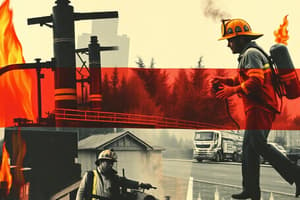Podcast
Questions and Answers
What is the term used for a fire extinguisher range that includes models that can be operated with one hand to large, wheeled models?
What is the term used for a fire extinguisher range that includes models that can be operated with one hand to large, wheeled models?
- Rapid Oxidation
- Extinguishing Agent (correct)
- Ignition Point
- Class A Fires
What stage of a fire can be controlled or extinguished without protective clothing?
What stage of a fire can be controlled or extinguished without protective clothing?
Incipient-stage
What type of fires involve ordinary combustibles such as wood and paper?
What type of fires involve ordinary combustibles such as wood and paper?
Class A fires
What type of fires involves flammable or combustible liquids?
What type of fires involves flammable or combustible liquids?
What type of fires involve energized electrical equipment?
What type of fires involve energized electrical equipment?
What type of fires involve combustible metals?
What type of fires involve combustible metals?
What type of fires are characterized by combustible cooking oils and fats?
What type of fires are characterized by combustible cooking oils and fats?
What organization developed the standards for portable fire extinguishers?
What organization developed the standards for portable fire extinguishers?
What is the scientific terminology for burning?
What is the scientific terminology for burning?
The temperature at which combustion begins is called the ______.
The temperature at which combustion begins is called the ______.
A fire extinguisher that uses carbon dioxide gas as the extinguishing agent is called a ______.
A fire extinguisher that uses carbon dioxide gas as the extinguishing agent is called a ______.
Dry-chemical fire extinguishers deliver a stream of very finely ground ______ onto a fire.
Dry-chemical fire extinguishers deliver a stream of very finely ground ______ onto a fire.
The process in which wet agents convert fatty acids in cooking oils to a soap is called ______.
The process in which wet agents convert fatty acids in cooking oils to a soap is called ______.
Which of the following correctly describes wet-chemical fire extinguishers?
Which of the following correctly describes wet-chemical fire extinguishers?
What are the steps of PASS?
What are the steps of PASS?
What is hydrostatic testing?
What is hydrostatic testing?
Flashcards are hidden until you start studying
Study Notes
Fire Extinguishing Agents and Fire Classes
- Extinguishing Agent: Fire extinguishers vary in size, from one-handed models to large wheeled types containing hundreds of pounds of extinguishing material.
- Incipient-stage Fire: Refers to the early stage of a fire that can be controlled with portable extinguishers without protective gear.
- Class A Fires: Involve ordinary combustibles like wood and paper; water is the primary extinguishing agent.
- Class B Fires: Involve flammable liquids such as gasoline and oils, with multiple extinguishing agents available.
- Class C Fires: Energized electrical equipment fires; agents used must not conduct electricity.
- Class D Fires: Combustible metal fires (e.g., magnesium, sodium); require special techniques and agents due to violent reactions with water.
- Class K Fires: Involves cooking oils and fats, requiring specific extinguishing methods.
Fire Extinguisher Classification and Ratings
- Underwriters Laboratories (UL): Organization responsible for developing standards and classifications for portable fire extinguishers.
- Dry-Chemical Extinguishers: Release finely ground particles; multipurpose types are rated for Class A, B, and C fires and prevent rekindling.
- Carbon Dioxide Extinguishers: Use CO2 gas, suitable for Class B and C fires.
- Wet-Chemical Extinguishers: Specifically designed for Class K fires; contain solutions like potassium carbonate that saponify cooking oils.
- Clean Agents: Halogenated agents that leave no residue, ideal for sensitive electronic environments.
Components and Operation of Fire Extinguishers
- Stored-Pressure Fire Extinguishers: Combine extinguishing agent and gas under pressure in one unit, equipped with a pressure gauge.
- Pump Tank Fire Extinguishers: Manual, non-pressurized units with short hoses for water dispensation.
- Wheeled Fire Extinguishers: Large units (150-350 pounds) mounted on wheels for easy transport.
- PASS Technique for Use:
- Pull the safety nozzle
- Aim the nozzle at the flame base
- Squeeze the trigger
- Sweep the nozzle across the flames
Hazard Classifications and Fire Load
- Fire Load: Amount/type of combustibles present in a building, categorized into light, ordinary, or extra hazards.
- Light Hazard Locations: Comprise mainly noncombustible materials with low fire spread risk.
- Ordinary Hazard Locations: Contain a moderate amount of Class A and B combustibles.
- Extra Hazard Locations: Feature a high amount of Class A combustibles or Class B flammables.
Miscellaneous Fire Terminology and Concepts
- Rapid Oxidation: Scientific term for burning, involving combustion processes.
- Ignition Point: Temperature at which fuel begins to burn.
- Hydrostatic Testing: Method to test extinguisher strength against ruptures.
- Wetting-Agent Water Extinguishers: Expel water designed to reduce surface tension for better penetration on fires.
- Tamper Seal and Locking Mechanism: Features in extinguishers designed for safety, preventing accidental discharge.
Studying That Suits You
Use AI to generate personalized quizzes and flashcards to suit your learning preferences.




